A Fuzzy Gain-Based Dynamic Ant Colony Optimization for Path Planning in Dynamic Environments
Abstract
:1. Introduction
- In the case of dynamic scenarios, there tends to be more uncertainty. Meta-heuristic approaches tend to converge more slowly to avoid a collision. Faster convergence of approximate algorithms while handling dynamic scenarios is a significant challenge.
- Maintaining the consistency of the algorithm when dealing with dynamic scenarios is another challenge to be addressed. The algorithms must be robust and stable in the unknown scenario.
- Though there are many algorithms in the literature for finding the collision-free shortest path, there is still a need for more intelligent algorithms with clear approximate and syllogistic reasoning.
- A fuzzy gain based dynamic ant colony optimization (FGDACO) for collision-free path planning in dynamic scenarios is proposed. The improved pheromone enhancement in the ant system will curtail unwanted traversals during the search.
- A fuzzy logic-based collision avoidance strategy based on approximate reasoning is proposed, in addition to the pheromone enhancement. This collision avoidance strategy is combined with gain enhanced ant colony optimization for safe path planning.
- The proposed algorithm was observed to converge faster with the improved pheromone enhancement and no local optima trap.
- The proposed algorithm was observed to be stable in all the scenarios with a lower deviation among the independent runs.
2. Preliminaries
2.1. Fuzzy Logic and Definitions
- (i).
- Fuzzification: the process of transforming a crisp value to a fuzzy value is called fuzzification. This transformation is realized using the membership function. As shown in Figure 1, triangular membership functions are used in this work. Each linguistic variable will have its fuzzy variable values defined in its universe of discourse. The fuzzy variables are characterized by the membership function, with their values in (0,1). In this work, the linguistic variables are relative distance to the target, angle towards the target, and distance towards the nearest obstacle. The fuzzy variable set for each linguistic variable is (low, medium, and high).
- (ii).
- Fuzzy Inference Engine: this is the critical unit of a fuzzy logic controller. The role of the fuzzy inference engine is to make decisions using the IF…THEN rules. The rules are represented as given below:
- (iii).
- Defuzzification: the fuzzy variables are converted to crisp outputs using the defuzzification phase. In this work, the centroid method is used for defuzzification. The defuzzified output x* obtained from the centroid method can be represented as the Equation (2)
2.2. Ant Colony Algorithm
3. Materials and Methods
3.1. Problem Definition and Formulation
3.2. Fuzzy Logic-Based Obstacle Avoidance
3.3. Gain Based Path Planning
Calculating Gain
3.4. Proposed FGDACO for Target Seeking and Obstacle Avoidance
3.4.1. Environment Perception
3.4.2. Ant Colony Parameters Initialization
3.4.3. Node Transition and Cost Calculation
- Distance to target
- 2.
- Nearest obstacle distance
- 3.
- Angle to be turned
3.4.4. Path Selection
| Algorithm 1 Framework for fuzzy gain-based dynamic ant colony optimization (FGDACO) |
| Input: G, N, S, D, |
| Output: best_path |
|
|
|
|
|
|
|
|
|
|
|
|
|
|
|
|
|
|
|
|
|
|
|
|
|
|
|
|
4. Experimental Results and Discussion
4.1. Experimental Setup and Dataset Description
- The start and destinations were considered to be the same during the whole process of path planning, but they differed with each scenario.
- The speed of the moving obstacles was considered as random between 0.5–1.5 m/s.
4.2. Performance Measures:
- Standard Deviation: The consistency of the proposed method was verified using standard deviation. The method was stable when there was less variation in the performance between independent runs.
- Median of path length and computation time: The median of the computational time and the length of path computed for 30 independent runs were compared and analyzed.
4.3. Parameter Setting:
4.4. Performance Evaluation
4.5. Discussion
- The proposed FGDACO outperformed COA, Fuzzy-GA, and FLACO by 6%, 11%, and 3%, respectively, in terms of length in scenario 1.
- The proposed FGDACO outperformed COA, Fuzzy-GA, and FLACO by 15%, 10%, and 4%, respectively, in terms of length in scenario 2.
- The proposed FGDACO outperformed COA, Fuzzy-GA, and FLACO by 8%, 10%, and 2%, respectively, in terms of length in scenario 3.
- With regard to consistency, FGDACO exhibited higher consistency, with a deviation of 2% on average among its independent runs.
5. Conclusions
Author Contributions
Funding
Institutional Review Board Statement
Informed Consent Statement
Data Availability Statement
Acknowledgments
Conflicts of Interest
References
- Yang, X.S. Nature-Inspired Algorithms and Applied Optimization; Springer: Berlin/Heidelberg, Germany, 2017; Volume 744. [Google Scholar]
- Boussaïd, I.; Lepagnot, J.; Siarry, P. A survey on optimization metaheuristics. Inf. Sci. 2013, 237, 82–117. [Google Scholar] [CrossRef]
- Tuncer, A.; Yildirim, M. Dynamic path planning of mobile robots with improved genetic algorithm. Comput. Electr. Eng. 2012, 38, 1564–1572. [Google Scholar] [CrossRef]
- Son, C. Intelligent rule-based sequence planning algorithm with fuzzy optimization for robot manipulation tasks in partially dynamic environments. Inf. Sci. 2016, 342, 209–221. [Google Scholar] [CrossRef]
- Bakdi, A.; Hentout, A.; Boutami, H.; Maoudj, A.; Hachour, O.; Bouzouia, B. Optimal path planning and execution for mobile robots using genetic algorithm and adaptive fuzzy-logic control. Robot. Auton. Syst. 2017, 89, 95–109. [Google Scholar] [CrossRef]
- Pandey, A.; Parhi, D.R. Optimum path planning of mobile robot in unknown static and dynamic environments using Fuzzy-Wind Driven Optimization algorithm. Def. Technol. 2017, 13, 47–58. [Google Scholar] [CrossRef]
- Hu, X.; Chen, L.; Tang, B.; Cao, D.; He, H. Dynamic path planning for autonomous driving on various roads with avoidance of static and moving obstacles. Mech. Syst. Signal. Process. 2018, 100, 482–500. [Google Scholar] [CrossRef]
- Chen, P.; Zhang, X.; Chen, X.; Liu, M. Path planning strategy for vehicle navigation based on user habits. Appl. Sci. 2018, 8, 407. [Google Scholar] [CrossRef] [Green Version]
- Wei, K.; Ren, B. A method on dynamic path planning for robotic manipulator autonomous obstacle avoidance based on an improved RRT algorithm. Sensors 2018, 18, 571. [Google Scholar] [CrossRef] [PubMed] [Green Version]
- Wang, M.; Liu, J.N. Fuzzy logic-based real-time robot navigation in unknown environment with dead ends. Robot. Auton. Syst. 2008, 56, 625–643. [Google Scholar] [CrossRef]
- Wu, Q.; Chen, Z.; Wang, L.; Lin, H.; Jiang, Z.; Li, S.; Chen, D. Real-Time Dynamic Path Planning of Mobile Robots: A Novel Hybrid Heuristic Optimization Algorithm. Sensors 2020, 20, 188. [Google Scholar] [CrossRef] [Green Version]
- Alomari, A.; Phillips, W.; Aslam, N.; Comeau, F. Dynamic fuzzy-logic based path planning for mobility-assisted localization in wireless sensor networks. Sensors 2017, 17, 1904. [Google Scholar] [CrossRef] [PubMed] [Green Version]
- Salehinejad, H.; Talebi, S. Dynamic fuzzy logic-ant colony system-based route selection system. Appl. Comput. Intell. Soft Comput. 2010, 2010, 1–13. [Google Scholar] [CrossRef] [Green Version]
- Purian, F.K.; Sadeghian, E. Mobile robots path planning using ant colony optimization and Fuzzy Logic algorithms in unknown dynamic environments. In Proceedings of the 2013 International Conference on Control, Automation, Robotics and Embedded Systems (CARE), Jabalpur, India, 16–18 December 2013; pp. 1–6. [Google Scholar]
- Song, Q.; Zhao, Q.; Wang, S.; Liu, Q.; Chen, X. Dynamic Path Planning for Unmanned Vehicles Based on Fuzzy Logic and Improved Ant Colony Optimization. IEEE Access 2020, 8, 62107–62115. [Google Scholar] [CrossRef]
- Hosseininejad, S.; Dadkhah, C. Mobile robot path planning in dynamic environment based on cuckoo optimization algorithm. Int. J. Adv. Robot. Syst. 2019, 16, 1729881419839575. [Google Scholar] [CrossRef]
- Bai, X.; Wen, W.; Hsu, L.T. Robust Visual-Inertial Integrated Navigation System Aided by Online Sensor Model Adaption for Autonomous Ground Vehicles in Urban Areas. Remote Sens. 2020, 12, 1686. [Google Scholar] [CrossRef]
- Singh, S.J.; Roy, S.; Singh, K.M.; Khelchandra, T. Motion planning of mobile robot using Fuzzy-GA method along with three path concept in dynamic environment. J. Intell. Fuzzy Syst. 2018, 35, 1445–1457. [Google Scholar] [CrossRef]
- Das, P.K.; Behera, H.S.; Jena, P.K.; Panigrahi, B.K. Multi-robot path planning in a dynamic environment using improved gravitational search algorithm. J. Electr. Syst. Inf. Technol. 2016, 3, 295–313. [Google Scholar] [CrossRef] [Green Version]
- Solak, S.; Yakut, Ö.; Dogru Bolat, E. Design and Implementation of Web-Based Virtual Mobile Robot Laboratory for Engineering Education. Symmetry 2020, 12, 906. [Google Scholar] [CrossRef]
- Bi, M. Control of Robot Arm Motion Using Trapezoid Fuzzy Two-Degree-of-Freedom PID Algorithm. Symmetry 2020, 12, 665. [Google Scholar] [CrossRef] [Green Version]
- Li, S.; Xie, J.; Wang, X.; Ren, F.; Zhang, X.; Bao, Q. Path Planning of Hydraulic Support Pushing Mechanism Based on Extreme Learning Machine and Descartes Path Planning. Symmetry 2021, 13, 97. [Google Scholar] [CrossRef]
- Zagradjanin, N.; Pamucar, D.; Jovanovic, K. Cloud-Based Multi-Robot Path Planning in Complex and Crowded Environment with Multi-Criteria Decision Making Using Full Consistency Method. Symmetry 2019, 11, 1241. [Google Scholar] [CrossRef] [Green Version]
- Sangeetha, V.; Krishankumar, R.; Ravichandran, K.S.; Kar, S. Energy-efficient green ant colony optimization for path planning in dynamic 3D environments. Soft Comput. 2021, 1, 21. [Google Scholar]
- Zhang, H.-Y.; Lin, W.-M.; Chen, A.-X. Path Planning for the Mobile Robot: A Review. Symmetry 2018, 10, 450. [Google Scholar] [CrossRef] [Green Version]
- Mac, T.T.; Copot, C.; Tran, D.T.; De Keyser, R. A hierarchical global path planning approach for mobile robots based on multi-objective particle swarm optimization. Appl. Soft Comput. 2017, 59, 68–76. [Google Scholar] [CrossRef]
- Liang, J.H.; Lee, C.H. Efficient collision-free path-planning of multiple mobile robots system using efficient artificial bee colony algorithm. Adv. Eng. Softw. 2015, 79, 47–56. [Google Scholar] [CrossRef]
- Fakoor, M.; Kosari, A.; Jafarzadeh, M. Humanoid robot path planning with fuzzy Markov decision processes. J. Appl. Res. Technol. 2016, 14, 300–310. [Google Scholar] [CrossRef] [Green Version]
- Das, P.K.; Behera, H.S.; Panigrahi, B.K. A hybridization of an improved particle swarm optimization and gravitational search algorithm for multi-robot path planning. Swarm Evol. Comput. 2016, 28, 14–28. [Google Scholar] [CrossRef]
- Zadeh, L.A. Fuzzy sets (PDF). Inf. Control 1965, 8, 338–353. [Google Scholar] [CrossRef] [Green Version]
- Mamdani, E.H. Application of fuzzy algorithms for control of simple dynamic plant. Proc. Inst. Electr. Eng. 1974, 121, 1585–1588. [Google Scholar] [CrossRef]
- Dorigo, M.; Maniezzo, V.; Colorni, A. Ant system: Optimization by a colony of cooperating agents. IEEE Trans. Syst. Man Cybern. Part B 1996, 26, 29–41. [Google Scholar] [CrossRef] [Green Version]
- Sangeetha, V.; Ravichandran, K.S.; Shekhar, S.; Tapas, A.M. An Intelligent Gain-based Ant Colony Optimisation Method for Path Planning of Unmanned Ground Vehicles. Def. Sci. J. 2019, 69, 167–172. [Google Scholar]
- Padhy, N.P. Artificial Intelligence and Intelligent Systems; Oxford University Press: Oxford, UK, 2005. [Google Scholar]
- Ravankar, A.; Ravankar, A.A.; Kobayashi, Y.; Hoshino, Y.; Peng, C.C. Path smoothing techniques in robot navigation: State-of-the-art, current and future challenges. Sensors 2018, 18, 3170. [Google Scholar] [CrossRef] [PubMed] [Green Version]
- MATLAB® (2019). 9.7.0.1261785 (R2019b); The MathWorks Inc.: Natick, MA, USA.

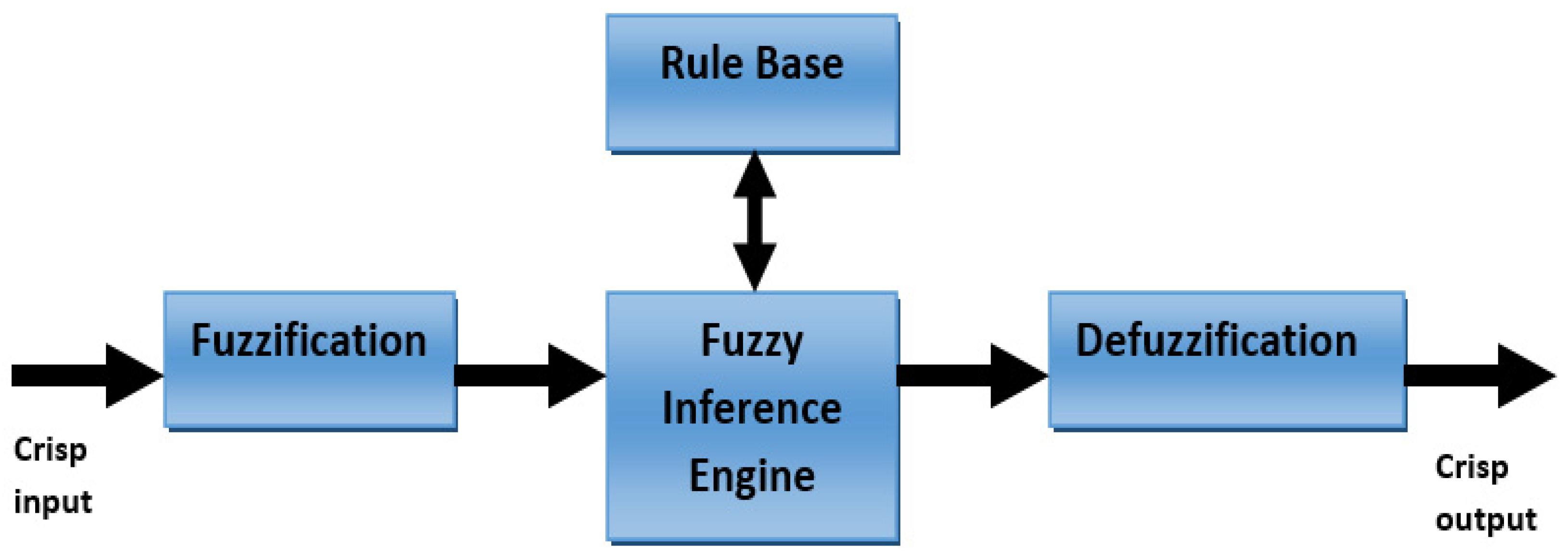



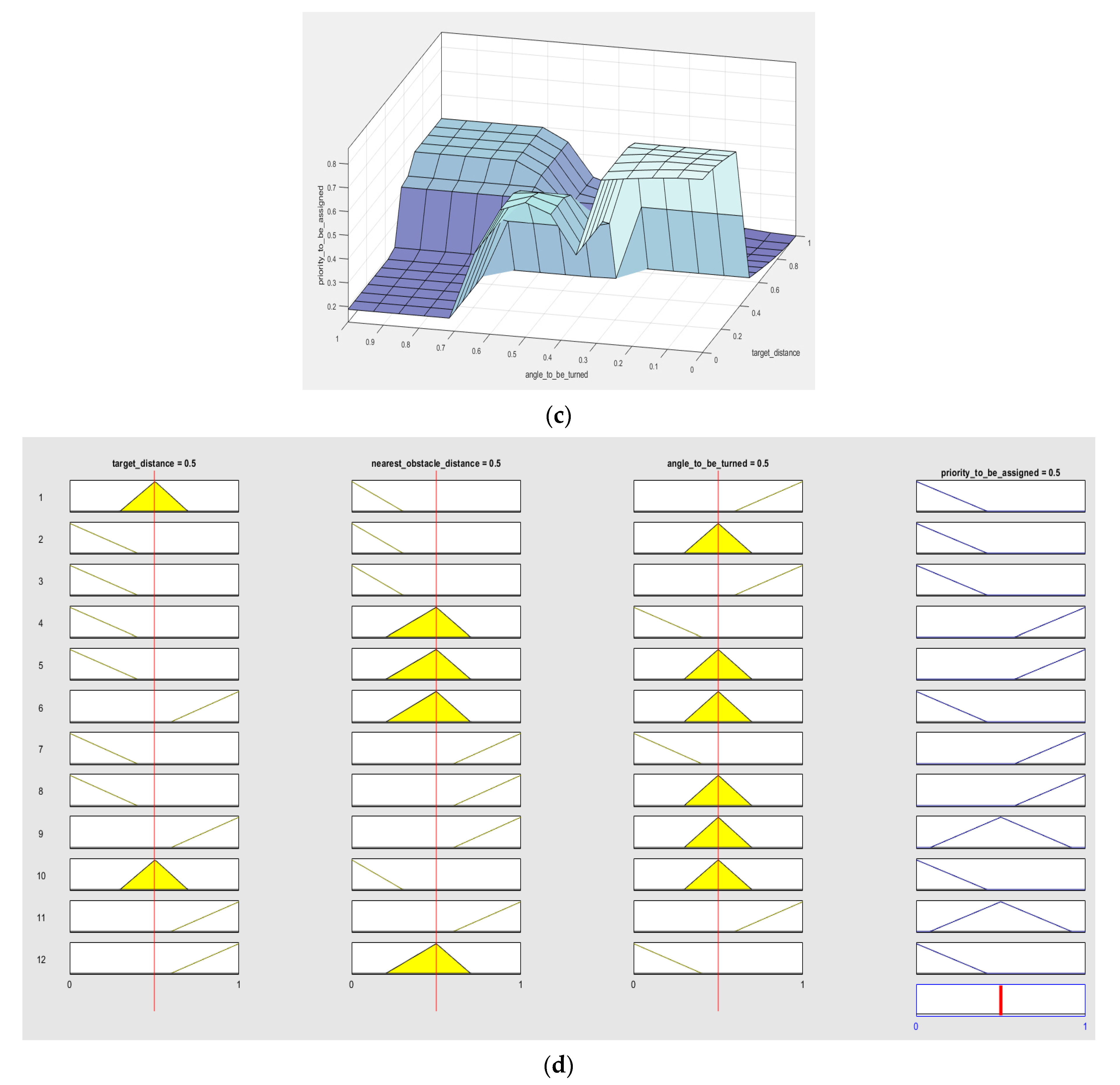
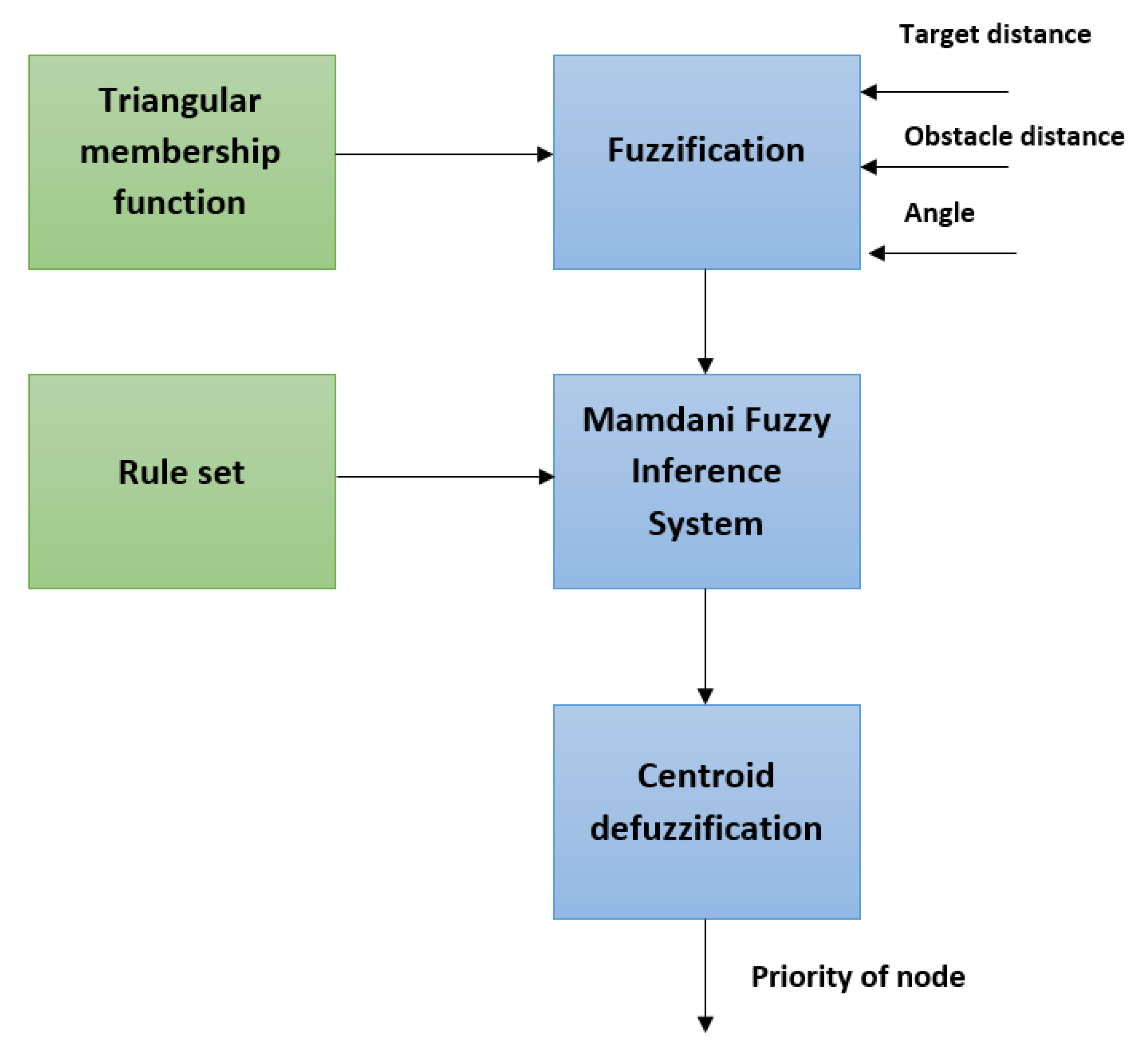
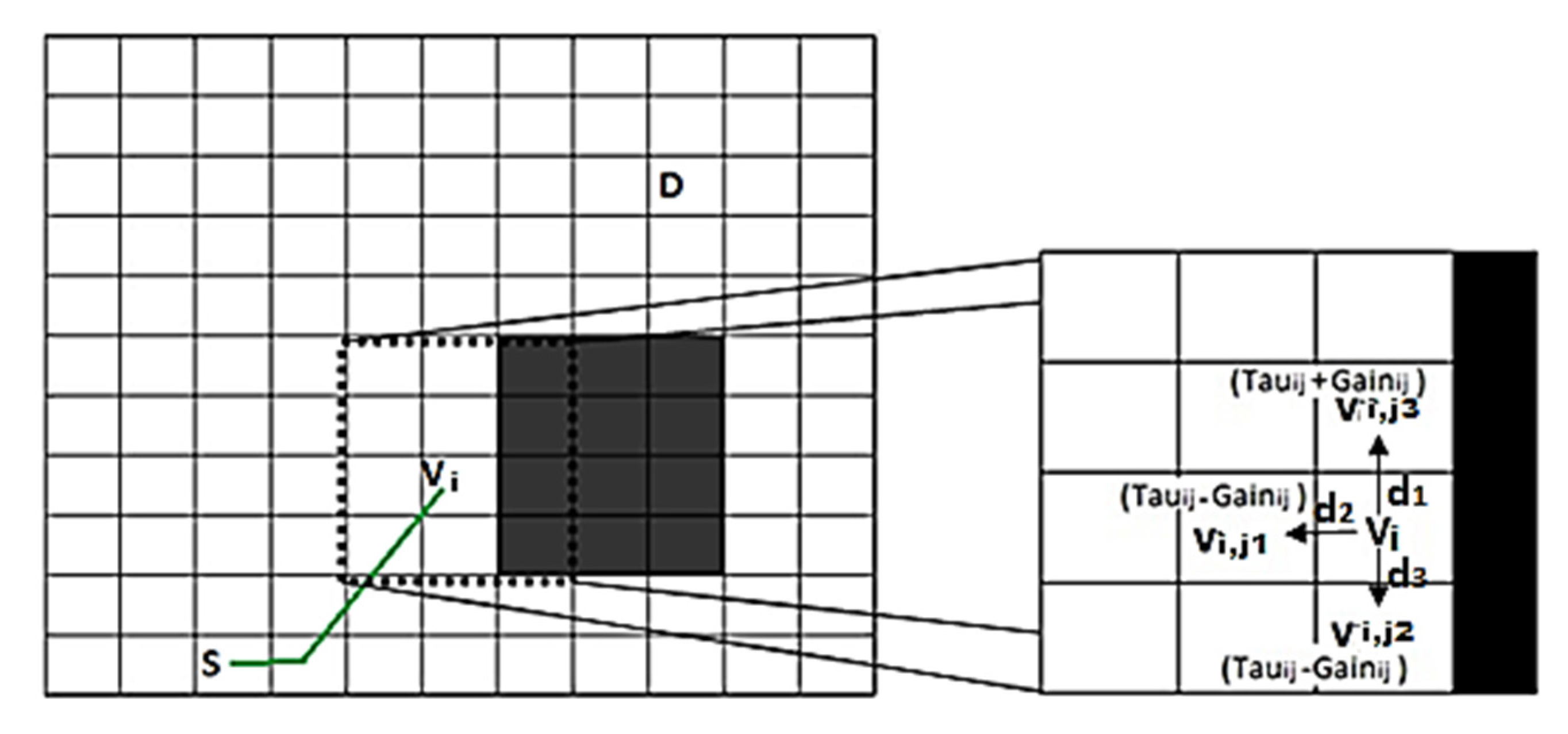

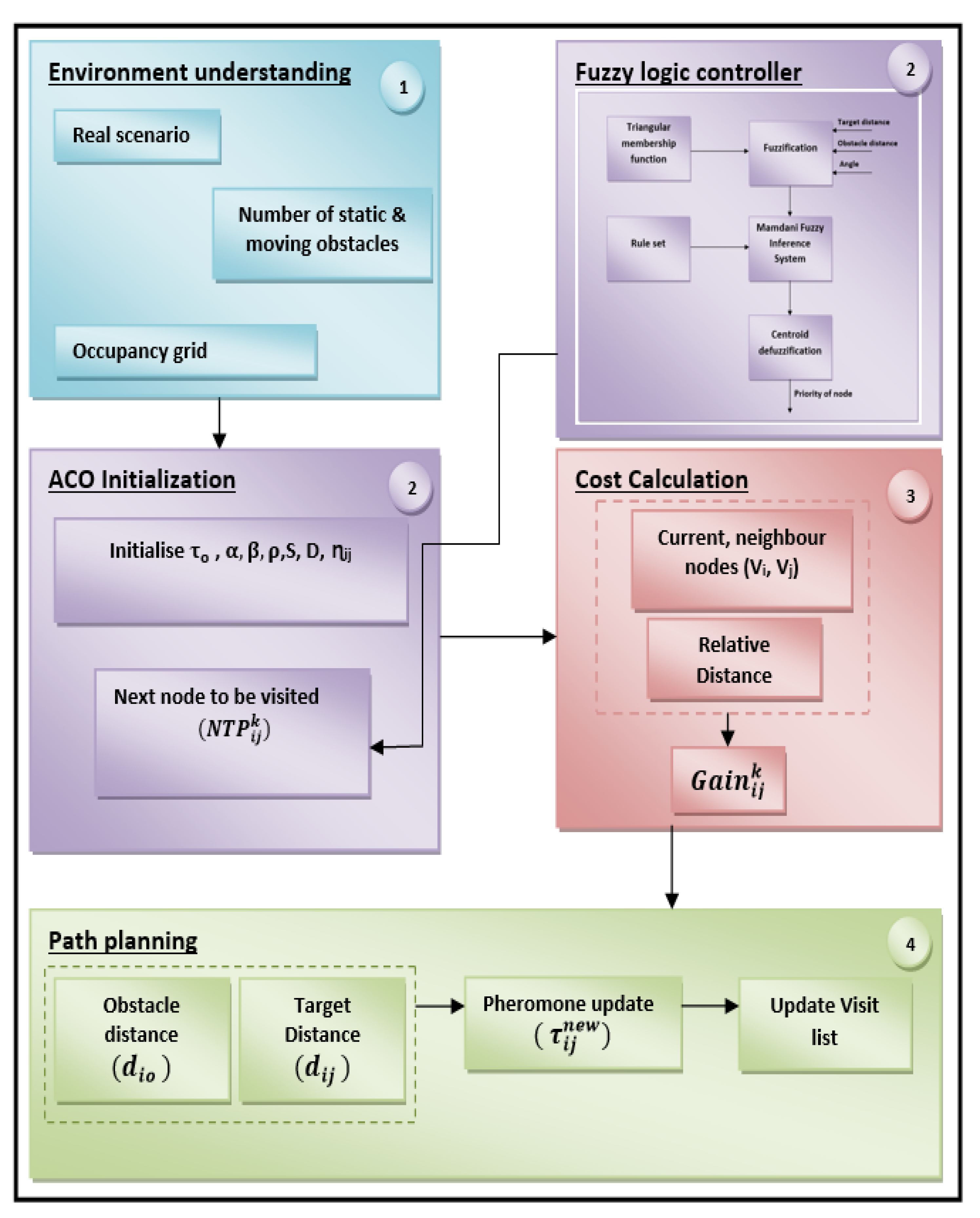



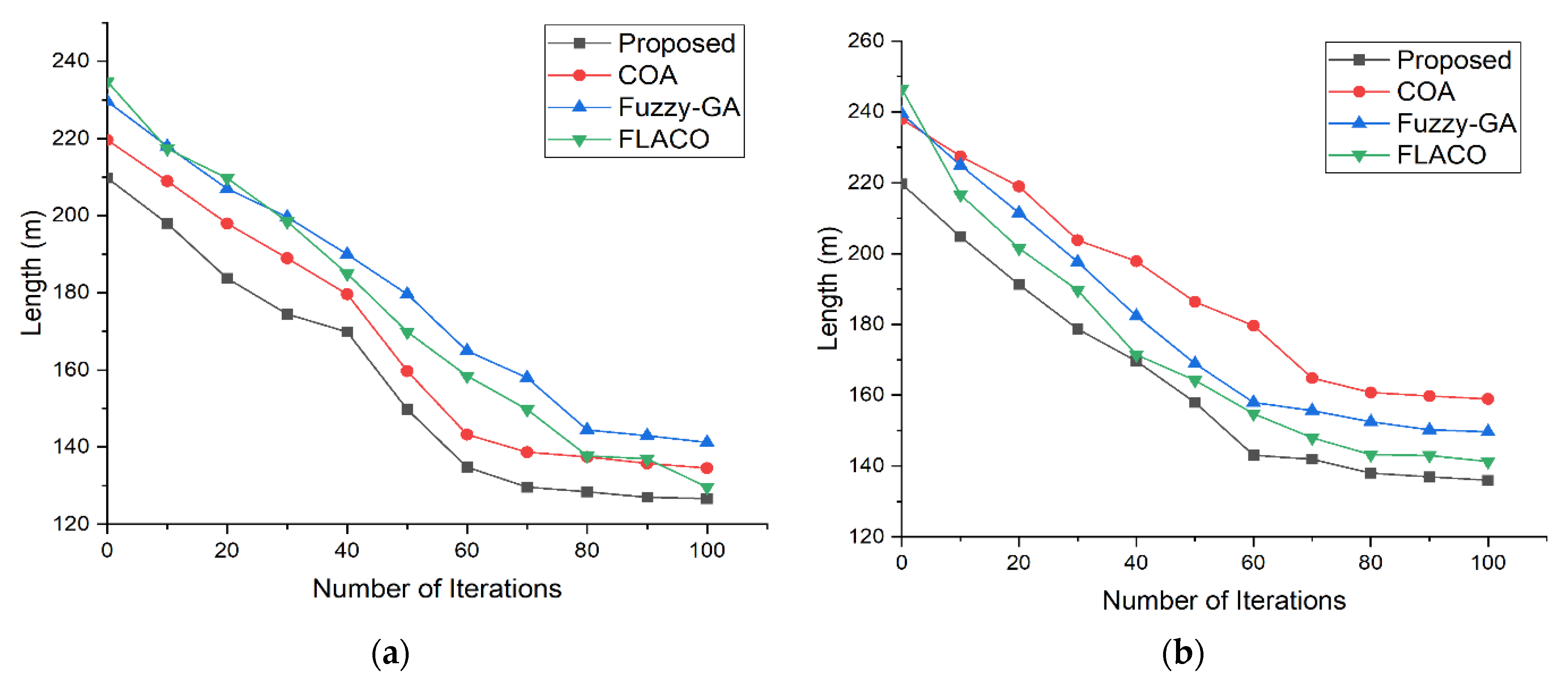
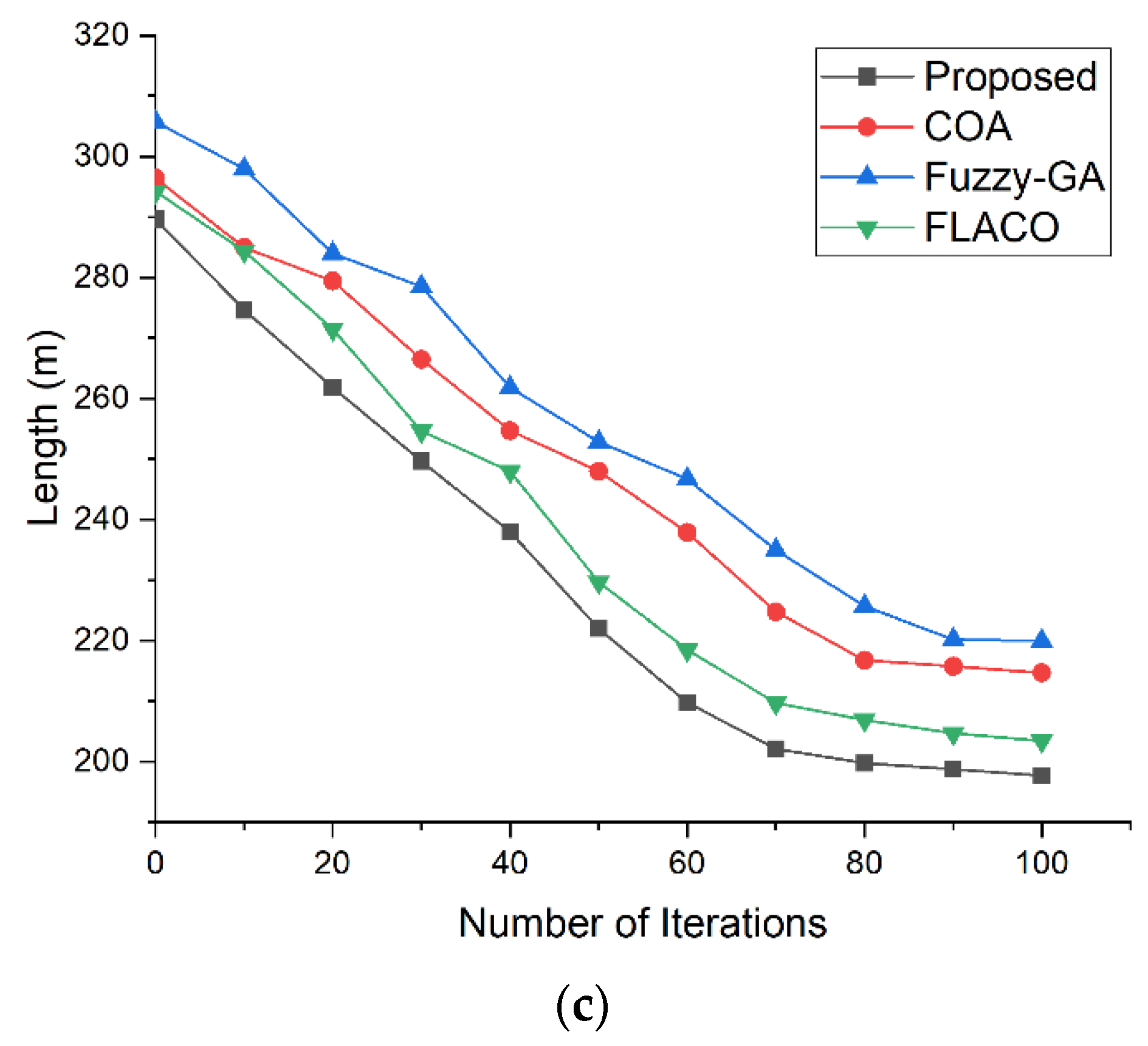

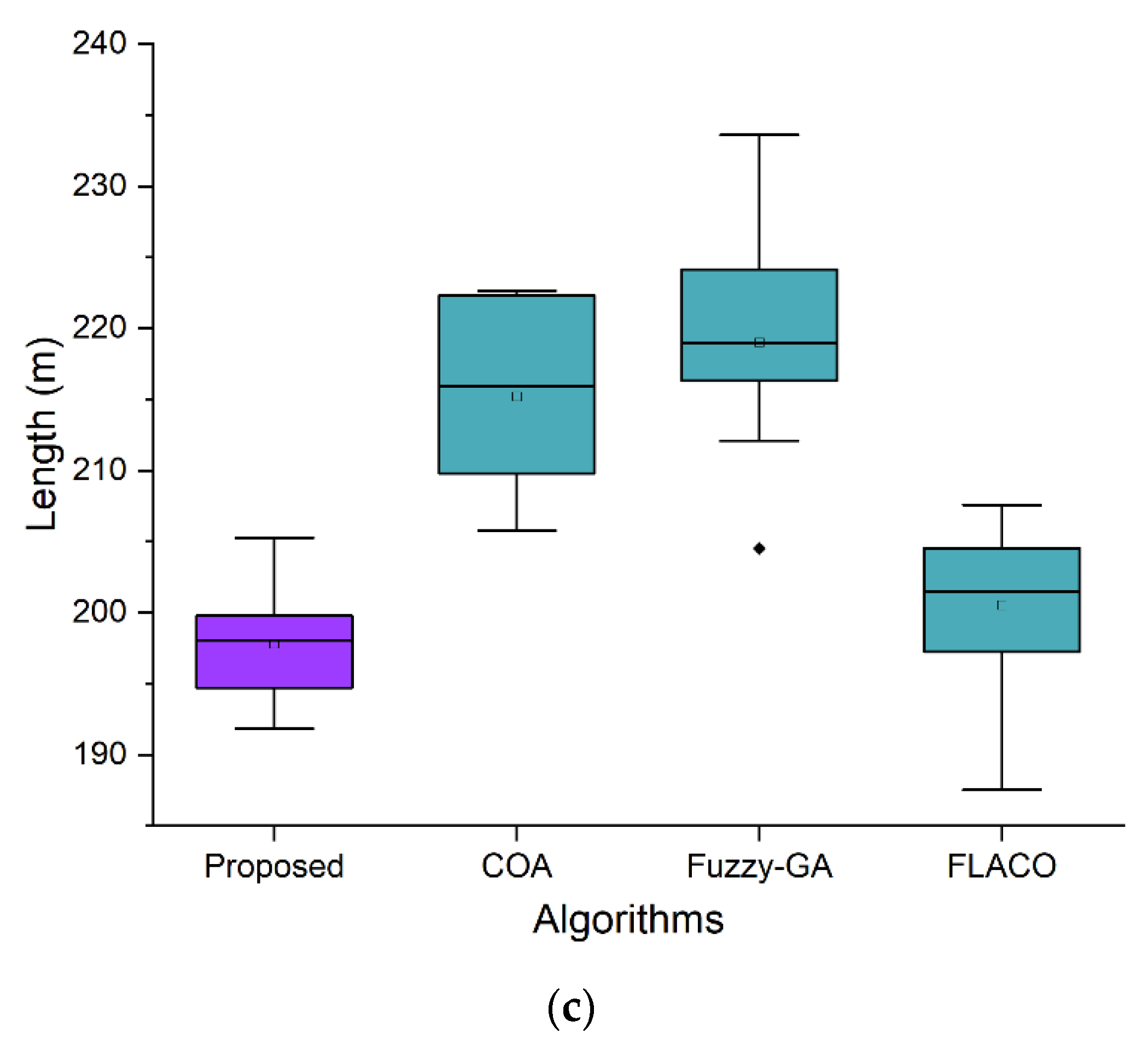
| Ref # | Method | Dataset | Optimality Achieved |
|---|---|---|---|
| [4] | Rule-based sequence planning algorithm with fuzzy optimization | Simulated scenarios | Flexibility and adaptability |
| [5] | Genetic algorithm and adaptive fuzzy logic control | RobuTER robot | Smooth collision-free path |
| [6] | Fuzzy wind-driven optimization | Real-time navigation using Khepera III mobile robot | Collision free path |
| [7] | Dynamic path planner | Simulated single and multi-lane roads | Static and dynamic safety, comfortability, appropriate acceleration and speed for the vehicle |
| [8] | Personalized path planner with fuzzy c-means clustering | Simulated grids, road simulation model in Changsha | Improved personalization of existing path planning |
| [9] | Improved rapidly exploring random tree (RRT) algorithm | Simulated and real-time implementation using MATLAB and robot operating system(ROS) | Correctness, effectiveness, and practicability |
| [10] | Fuzzy logic | Real-time navigation using mobile robot on long u shape, large concave, cluttered, maze-like dynamic environments | Minimum risk and global convergence |
| [11] | Hybrid heuristic optimization algorithm (Beetle antennae search) | Virtual map and the real map | Accelerated convergence speed |
| [12] | Dynamic Fuzzy logic based path planning | Wireless sensor networks in MATLAB | Localization ratio and localization accuracy |
| [13] | Dynamic fuzzy-logic-ant colony system | Regions of London, United Kingdom | Efficient route selection |
| [14] | Ant colony and fuzzy logic | Simulated maps in MATLAB | Shortest path in minimum time |
| [15] | Fuzzy logic ant colony optimization | Simulated road networks | Shortest path length |
| [16] | Cuckoo optimization algorithm | Simulated scenarios of size 20 × 20, 100 × 100 and 200 × 200 | Safe, smooth, and collision-free path |
| [17] | A visual-inertial navigation system | Urban areas of Hong Kong | Effective mitigation of dynamic objects and improved accuracy |
| [18] | Fuzzy- genetic algorithm (GA) with three path concept | Simulated maps | Computationally efficient |
| [19] | Improved gravitational search | Real-time navigation using Khepera III mobile robot | The safe and shortest path |
| [20] | Genetic algorithm | Web based virtual mobile robot laboratory | Usability of remote controlled robot laboratory |
| [21] | Trapezoid fuzzy 2 DOF algorithm | Simulated proportional integral derivative (PID) control system | Faster response with low position tracking error |
| [22] | Extreme Learning Machine and Descartes | Virtual simulation in Unity3D | Reduced local error and correction error |
| [23] | Full Consistency method with D* Lite | Simulated occupancy maps | Consistent determination of weight factors for effective risk management during motion |
| [24] | Improved Ant colony optimization | Elevation data from international society for photogrammetry and remote sensing (ISPRS) and United States geological survey (USGS) | Faster convergence |
| Parameter | Description |
|---|---|
| N | Number of ants |
| Initial pheromone | |
| Quantity of pheromone deposited while traversing from i to j | |
| Heuristic function indicating the visibility of route between i and j; | |
| Cost of the route (i,j) obtained by kth ant | |
| α | Impact of pheromone on the choice of next node |
| β | Impact of heuristic function on the selection of next node |
| Rate of pheromone evaporation; 0 < < 1 | |
| A table containing nodes that are feasible to be visited by kth ant | |
| Q | Constant related to the pheromone increment |
| Linguistic Variable | |||
|---|---|---|---|
| relative distance to the target | (0,0.4) | (0.3,0.7) | (0.6,1) |
| angle towards the target | (0,0.4) | (0.3,0.7) | (0.6,1) |
| distance towards the nearest obstacle | (0,0.3) | (0.2,0.7) | (0.6,1) |
| IF | IF | IF | Then |
|---|---|---|---|
| Relative distance to the target | Angle to be turned | Distance to the nearest obstacle | The priority of the node during next node selection in ant colony |
| Medium | High | low | Low |
| Low | Medium | Low | Low |
| Low | High | Low | Low |
| Low | Low | Medium | High |
| Low | Medium | Medium | Medium |
| High | Medium | Medium | Low |
| Low | Low | High | High |
| Low | Medium | High | High |
| High | Medium | High | Medium |
| Medium | Medium | Low | Low |
| High | High | High | Medium |
| High | Low | Medium | Low |
| Scenario | Static Obstacle | Moving Obstacle |
|---|---|---|
| 1 | 3 | 3 |
| 2 | 4 | 3 |
| 3 | 2 | 3 |
| Parameter | Value |
|---|---|
| α | 0.5 |
| β | 0.5 |
| ρ | 0.5 |
| Time interval | 3 ∆t |
| Sampling interval | 10 s |
| Number of iterations | 100 |
| Number of independent runs of the algorithm | 30 |
| Number of ants (N) | 20 |
| Scenario # | Algorithm | Time (s) | Length (m) | ||
|---|---|---|---|---|---|
| Median | SD | Median | SD | ||
| 1 | Proposed FGDACO | 28.97 | 2.24 | 126.65 | 1.37 |
| COA | 37.94 | 4.35 | 134.57 | 3.48 | |
| Fuzzy-GA | 41.79 | 4.58 | 141.24 | 5.69 | |
| FLACO | 31.47 | 3.77 | 129.64 | 2.78 | |
| 2 | Proposed FGDACO | 38.74 | 1.97 | 135.96 | 2.37 |
| COA | 51.76 | 4.69 | 158.96 | 4.99 | |
| Fuzzy-GA | 48.61 | 3.47 | 149.67 | 6.35 | |
| FLACO | 43.78 | 2.07 | 141.27 | 3.78 | |
| 3 | Proposed FGDACO | 74.33 | 2.54 | 197.69 | 2.77 |
| COA | 84.95 | 4.77 | 214.68 | 5.78 | |
| Fuzzy-GA | 81.31 | 3.18 | 219.96 | 6.35 | |
| FLACO | 77.12 | 2.11 | 201.43 | 4.69 | |
Publisher’s Note: MDPI stays neutral with regard to jurisdictional claims in published maps and institutional affiliations. |
© 2021 by the authors. Licensee MDPI, Basel, Switzerland. This article is an open access article distributed under the terms and conditions of the Creative Commons Attribution (CC BY) license (http://creativecommons.org/licenses/by/4.0/).
Share and Cite
Sangeetha, V.; Krishankumar, R.; Ravichandran, K.S.; Cavallaro, F.; Kar, S.; Pamucar, D.; Mardani, A. A Fuzzy Gain-Based Dynamic Ant Colony Optimization for Path Planning in Dynamic Environments. Symmetry 2021, 13, 280. https://doi.org/10.3390/sym13020280
Sangeetha V, Krishankumar R, Ravichandran KS, Cavallaro F, Kar S, Pamucar D, Mardani A. A Fuzzy Gain-Based Dynamic Ant Colony Optimization for Path Planning in Dynamic Environments. Symmetry. 2021; 13(2):280. https://doi.org/10.3390/sym13020280
Chicago/Turabian StyleSangeetha, Viswanathan, Raghunathan Krishankumar, Kattur Soundarapandian Ravichandran, Fausto Cavallaro, Samarjit Kar, Dragan Pamucar, and Abbas Mardani. 2021. "A Fuzzy Gain-Based Dynamic Ant Colony Optimization for Path Planning in Dynamic Environments" Symmetry 13, no. 2: 280. https://doi.org/10.3390/sym13020280







